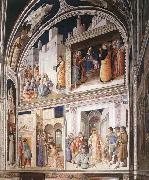Wholesale Oil Painting No Minimum |
|||||||||||
|
|
|||||||||||

|
|||||||||||
|
|
|
||||||||
Fra AngelicoFra Angelico Galleries b.c. 1400, Vicchio, Florence d.Feb. 18, 1455, Rome Fra Angelico (c. 1395 ?C February 18, 1455), born Guido di Pietro, was an Early Italian Renaissance painter, referred to in Vasari's Lives of the Artists as having "a rare and perfect talent". Known in Italy as il Beato Angelico, he was known to his contemporaries as Fra Giovanni da Fiesole (Brother John from Fiesole). In Giorgio Vasari's Lives of the Artists, written prior to 1555, he was already known as Fra Giovanni Angelico (Brother Giovanni the Angelic One). Within his lifetime or shortly thereafter he was also called Il Beato (the Blessed), in reference to his skills in painting religious subjects. In 1982 Pope John Paul II conferred beatification, thereby making this title official. Fiesole is sometimes misinterpreted as being part of his formal name, but it was merely the name of the town where he took his vows, used by contemporaries to separate him from other Fra Giovannis. He is listed in the Roman Martyrology as Beatus Ioannes Faesulanus, cognomento Angelicus??"Blessed Giovanni of Fiesole, nicknamed Angelico". Fra Angelico was working at a time when the style of painting was in a state of change. This process of change had begun a hundred years previous with the works of Giotto and several of his contemporaries, notably Giusto de' Menabuoi, both of whom had created their major works in Padua, although Giotto was trained in Florence by the great Gothic artist, Cimabue, and painted a fresco cycle of St Francis in the Bardi Chapel in Santa Croce. Giotto had many enthusiastic followers, who imitated his style in fresco, some of them, notably the Lorenzetti, achieving great success. |
||||||||
|
|
||||||||
Scenes from the Lives of Sts Lawrence and Stephen
Scenes from the Lives of Sts Lawrence and Stephen Painting ID:: 63526 |
1447-49 Fresco Cappella Niccolina, Palazzi Pontifici, Vatican Fra Angelico was entrusted with a number of commissions for the Vatican Palace. The one that involved the most work was the decoration of the small room in the ancient tower of Pope Innocent III that Nicholas V turned into his private chapel, a rectangular space with a groin vault. The floor installed at this time survives. It displays the emblem of Nicholas V, a radiant sun. The frescoes show scenes from the lives of Sts Stephen and Lawrence, in two horizontal bands. On the rear wall was a Deposition, also by Fra Angelico and mentioned by Vasari, but now lost. On the arches are the eight Doctors of the Church in Gothic aedicules. The Evangelists are on the vault, while on the window jambs rosettes with the head of Christ alternate with heads of patriarchs and prophets. The cycle is generally attributed to Fra Angelico and his workshop. The hand of Benozzo Gozzoli has been identified in some of the scenes from the life of St Stephen. Painted for the jubilee of 1450, the cycle clearly reveals the program pursued by Nicholas V of a link between Christian and classical culture. Fra Angelico's figures have a "Roman" appearance: they stand solemn and serious, like heroes from antiquity, against a background of theatrical architecture, reminding the beholder of the buildings of ancient Rome. The intention was to underline the continuity between imperial and Christian Rome which the pope wished to assert. In the picture shown in the upper register St Stephen is depicted preaching to the people and the scholars. Below this St Lawrence is shown receiving the church's treasury and distributing it to the poor.Artist:ANGELICO, Fra Title: Scenes from the Lives of Sts Lawrence and Stephen Painted in 1401-1450 , Italian - - painting : religious 1447-49 Fresco Cappella Niccolina, Palazzi Pontifici, Vatican Fra Angelico was entrusted with a number of commissions for the Vatican Palace. The one that involved the most work was the decoration of the small room in the ancient tower of Pope Innocent III that Nicholas V turned into his private chapel, a rectangular space with a groin vault. The floor installed at this time survives. It displays the emblem of Nicholas V, a radiant sun. The frescoes show scenes from the lives of Sts Stephen and Lawrence, in two horizontal bands. On the rear wall was a Deposition, also by Fra Angelico and mentioned by Vasari, but now lost. On the arches are the eight Doctors of the Church in Gothic aedicules. The Evangelists are on the vault, while on the window jambs rosettes with the head of Christ alternate with heads of patriarchs and prophets. The cycle is generally attributed to Fra Angelico and his workshop. The hand of Benozzo Gozzoli has been identified in some of the scenes from the life of St Stephen. Painted for the jubilee of 1450, the cycle clearly reveals the program pursued by Nicholas V of a link between Christian and classical culture. Fra Angelico's figures have a "Roman" appearance: they stand solemn and serious, like heroes from antiquity, against a background of theatrical architecture, reminding the beholder of the buildings of ancient Rome. The intention was to underline the continuity between imperial and Christian Rome which the pope wished to assert. In the picture shown in the upper register St Stephen is depicted preaching to the people and the scholars. Below this St Lawrence is shown receiving the church's treasury and distributing it to the poor.Artist:ANGELICO, Fra Title: Scenes from the Lives of Sts Lawrence and Stephen Painted in 1401-1450 , Italian - - painting : religious |
|||||||
|
CONTACT US |

